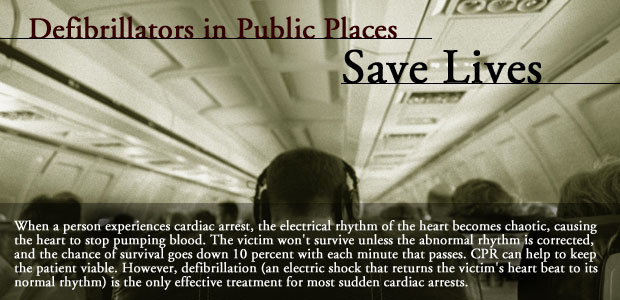
| Clinical Leadership |
|
|
|
The short window of opportunity to save the life of a cardiac arrest victim is a key reason why commercial airlines were among the first public locations where automated external defibrillators (AEDs) were widely installed. An airplane, even when circling directly above an airport, typically takes at least 20 minutes to land. "A person experiencing sudden cardiac arrest on an airplane has essentially no chance of surviving without early defibrillation," said Dr. Richard Page. Page is head of the division of cardiology and the Robert A. Bruce Professor of Medicine at the UW. His background is in clinical cardiac electrophysiology. The first AEDs were installed in the American Airlines fleet in 1997 because, Page noted, "Their medical director decided it was the right thing to do." A paper published by Page and his colleagues in the October 26, 2000 New England Journal of Medicine confirmed that it was safe and effective to use AEDs on airlines. The report described 200 uses, beginning in 1997, of AEDs on aircraft. In 100 percent of the cases reported, the AEDs accurately determined whether the passenger needed to receive a shock to regain the normal rhythm of the heart. Of 15 individuals who needed shock and received it, six survived and were discharge from the hospital at their previous level of functioning. A paper published in the same edition of the New England Journal of Medicine found similar effectiveness in the use of AEDs in casinos. Because casinos continuously videotape their public areas, a wealth of information is on record about these incidents, including exactly how long it took to employ the AEDs. Seventy-four percent of people shocked within three minutes of cardiac arrest survived to walk out of the hospital. These statistics are impressive when contrasted with survival rates of five years ago on the congested streets of New York or Chicago. Due to the difficulty of reaching heart attack victims quickly, the survival rate in these cities was less than two percent. AEDs are simple and safe to use. A Seattle study, using mannequins as "victims," determined that sixth graders could figure out how to use an AED in 90 seconds, with no training. AEDs will not shock a normal beating heart. The AED actually talks to its users. The equipment directs the user through the steps sequentially with instructions such as "remove all clothing from the patient's chest" and "shock advised, do not touch the patient." According to the American Heart Association, approximately 225,000 Americans die each year from cardiac arrest. An estimated 20,000 lives could be saved each year if AEDs were readily available in public places. More than 500 AEDs are installed in public places in King County. The cost for a single AED is about $2,000 and dropping. Home units are also available, and units for children have been installed in some schools. Page likens AEDs to fire extinguishers: "It just makes sense to have them available, even if they are never used." |
|
© 2003 - 2004 UW Medicine
Maintained by UW Health Sciences and Medical Affairs News and Community Relations Send questions and comments to drrpt@u.washington.edu |


